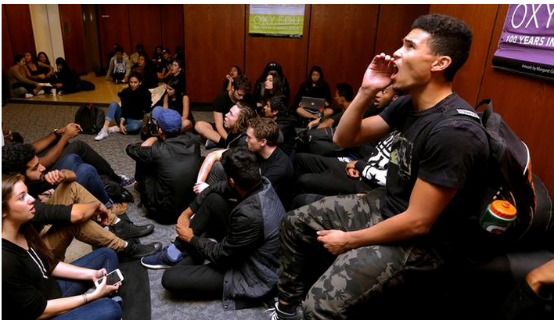
In the 1960s, a casual but still effective saying summarized the rebelliousness(叛逆性) of youth: “Don't trust anyone over 30.” As it turns out, that warning is a much more suitable bumper sticker (保险杠大头贴) for today's student activists than it was 50 years ago. Young people now — the post-millennials (千禧年之后) — face a far deeper generational divide than the one that separated baby boomers from their parents. And the nation faces a far more serious crisis if that divide cannot be bridged.
The wave of mostly white, mostly middle-class boomers that flooded college campuses in the 1960s got swept up in a variety of causes — Vietnam, civil rights, feminism. They questioned authority in ways their Depression- and World War II-era parents never did. Yet it could be argued that most of them had little reason in general to object to the status quo (现状). They had benefited from post-World War II prosperity and government programs, such as the GI Bill, that allowed their parents to raise them in comfortable suburban homes and send them to free, decent public schools. Later, Great Society initiatives such as the Higher Education Act of 1965 enabled them to attend college in historic numbers at a reasonable cost, and there were jobs immediately after graduation.
Back then, public investments in America's families and youth were embraced by older generations who wanted their children and grandchildren to achieve the American dream. The situation — and the demography(人口统计学) — is much different today.
The younger population of the U.S. is now highly diverse. Racial minorities, who are not always from the middle class, represent roughly half of the students in the nation's K-12 public schools. That level of diversity is destined to increase: Since the 2010 census, in 46 out of 50 states and in nearly 9 out of 10 of the country's 3,100 counties, more white youths have turned 20 than were born or in-migrated. By 2023, whites will comprise less than half of the U.S. population under age 30. More importantly, the entire white working-age population will decline by 12 million over the next 15 years because of aging and retirement; that means young Latinos, blacks, Asians and other minorities must take their place.
本时文内容由奇速英语国际教育研究院原创编写,禁止复制和任何商业用途,版权所有,侵权必究!
1.Why does the author say in the first paragraph “that warning is a much more suitable bumper sticker for today's student activists than it was 50 years ago”?
A The author thinks it is a better way for today’s student activists to show their emotion than 50 years ago.
B The author thinks younger generation nowadays is more fashionable than 50 years ago.
C The author thinks the method adopted by younger generation to convey their ideas is so different from the one 50 years ago.
D The author thinks it is time to recognize the sharp divide between the younger generation and the one 50 years ago.
解析:选D。推理判断题。结合第一段最后几句话,可以得知:主要指现在年青人与老一辈人的观念差异。ABC都是指表象,故选D。
2.From the passage, we know mostly whites flooded the college campus are intended for________________.
A their civil rights
B educational rights
C minority rights
D questioning the authority of the time
解析:选D。细节理解题。根据第二段开头,故选D。
3.About the behaviors of younger generation, the attitude of the author tends to be_______________.
A positive
B negative
C supportive
D practical
解析:选B。细节理解题。从第二段第二句的“had little reason in general to object to the status quo”得知,故选B。
4.From the context, The best title will possibly be___________________.
A the new racial generation gap
B the younger generation of the US
C the generation gap
D the Whites in the US
解析:选A。文章标题题。全文通过对新老美国人的观念的不同,指出美国人口多样化的趋势是必然的结局,这就要求政府要重视这一形势下的种族代沟问题。其它几个或不全,或过于笼统,故选A。